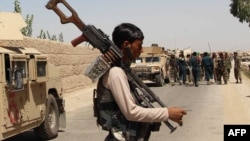CHAH-E ANJIR, Afghanistan -- A small remote Afghan village looks a lot like a World War I front line a century ago.
Uniformed Afghan forces and turbaned Taliban insurgents are now fighting over every house, wall, field, and orchard in Chah-e Anjir, a nondescript agricultural village in southern Afghanistan’s volatile Helmand Province.
Chah-e Anjir is part of Nad-e Ali district, where rapid Taliban advances this month have put the provincial capital Lashkar Gah under a virtual siege by insurgents.
The ongoing fighting is part of a Taliban push to overrun Helmand, Afghanistan’s largest province. The region is the global epicenter of poppy cultivation and the drug trade. After nearly 18 months of fighting, the Taliban now control or contest 12 of its 14 districts. This week, the Taliban closed the major highway linking Lashkar Gah to the rest of the country’s main road network.
Exhausted Afghan soldiers have made few advances after days of intense fighting that has seen constant small and heavy weapons firing.
“We are here to defend our homeland. We have pushed the Taliban back,” said an Afghan Army soldier who requested not to be identified.
The Taliban, however, appear far from being defeated. While the Afghan special forces have been able to reclaim one police check post from the insurgents, the Taliban are fighting back everywhere. The whole village has turned into a venue for trench warfare.
Even the trees and the maize and cotton crops are wilting -- all the farmers fled last week.
“The reinforcements who have arrived from the capital, particularly the special forces, are reclaiming lost territories,” provincial spokesman Omar Zhwak told Radio Free Afghanistan on August 10. “We have seen some advances, but the enemy is also resisting.”
There are hardly any reliable casualty figures as both sides claim to have killed a large number of their opponents. But one Afghan Army soldier said the Taliban snipers are deadly.
Speaking on the condition of anonymity because he was not allowed to talk to journalists, he said nine of his colleagues were killed or injured by enemy snipers during the past three days. Everyone in Chah-e Anjir has been warning about the Taliban snipers.
“I think the enemy is taking much more casualties both from ground fire and airstrikes,” he said.
A tribal leader in Chah-e Anjir said there have been at least 11 civilian casualties since the beginning of the month. Like the government soldiers, he too was reluctant to be identified by name.
As they faced government reinforcements in Nad-e Ali, the Taliban quickly moved their sights to the neighboring district of Nawa-e Barakzai, where they overran outlying villages before entering a pitched battle late on August 9.
District police chief Ahmad Shah Saleh warned that without reinforcements the district is likely to be overrun by the Taliban.
“We demanded help but have not received any,” he told Radio Free Afghanistan on August 9. “The enemy is now completely focused on Nawa. Without quick reinforcements, we will be backed in a corner.”
The Taliban appeared to be in control most of Nawa-e Barkazai late on August 10. There were some reports of intense fighting around the district center.
On August 10, the Afghan government sent fresh reinforcements to boost Lashkar Gah’s defenses. But civilians there are concerned over the Taliban’s rapid advances.
“We are worried because we’re not sure whether the government will prevail or this city will fall to the insurgents,” one resident said.
Abubakar Siddique wrote this story based on Mohammad Ilyas Dayee's reporting from Chah-e Anjir, Helmand.
fg/















